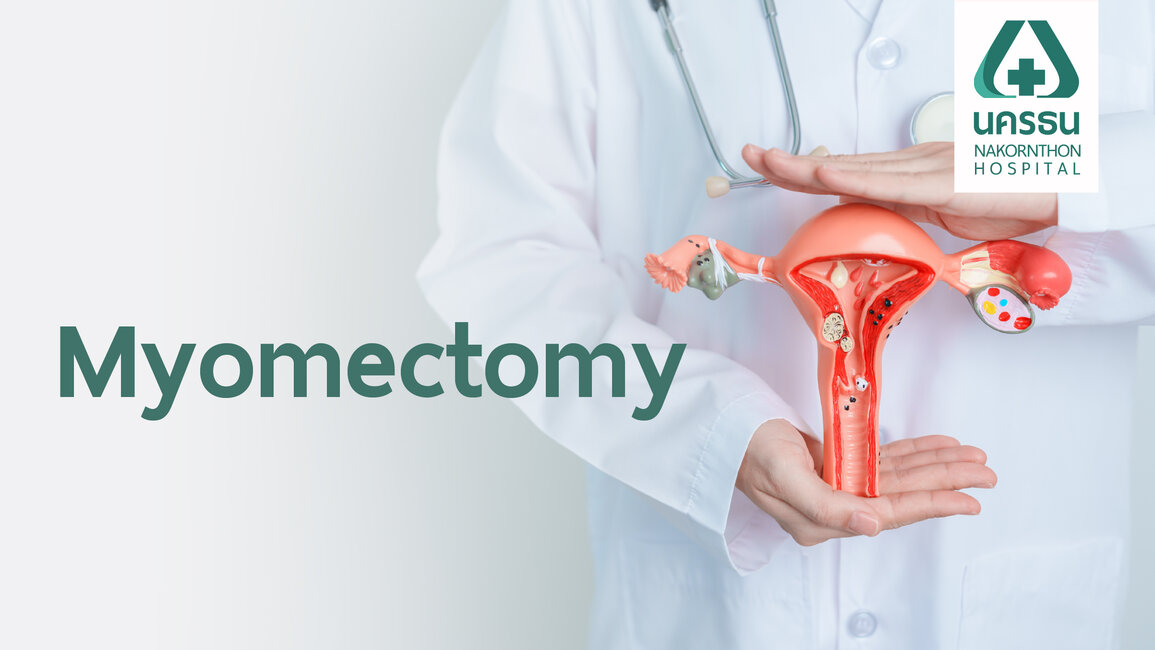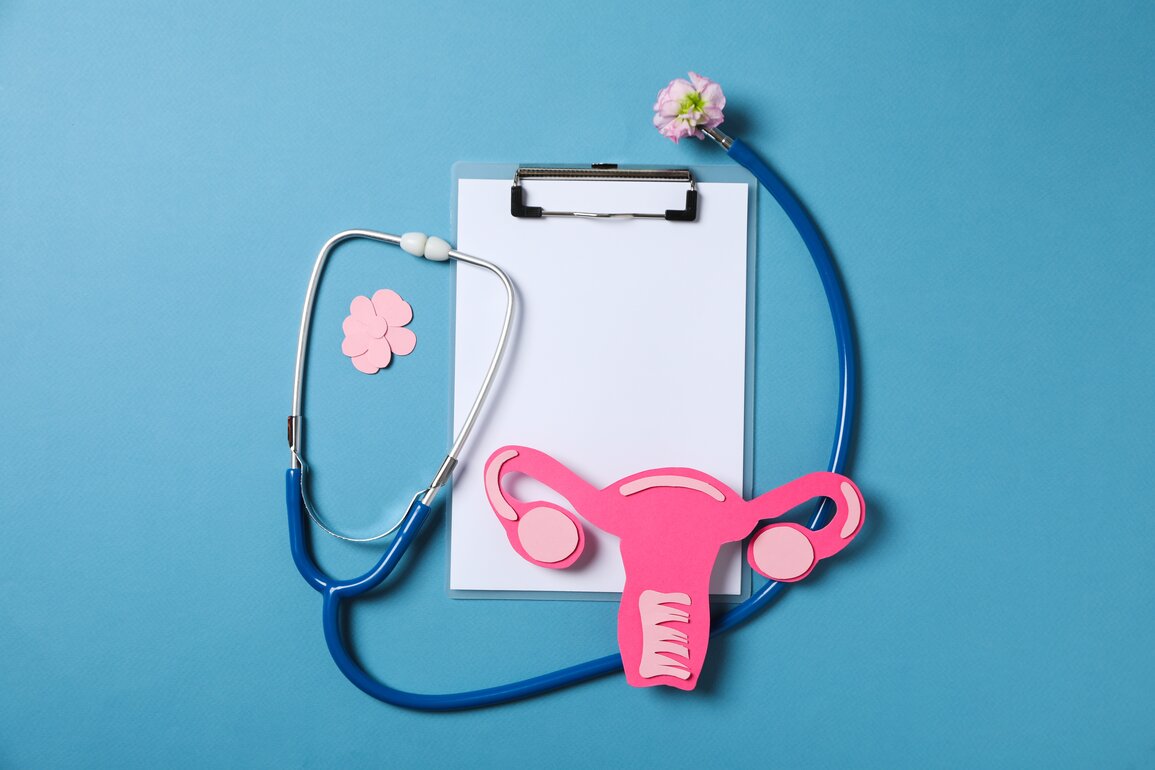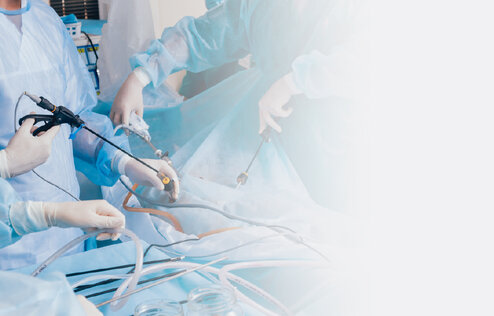Myomectomy Guide: Purpose, Procedure & Possible Risks
Center : Women Health Center
Article by : Dr. Jutaporn Uthaisan

Myomectomy is a surgical procedure that treats uterine fibroids without removing the uterus. It preserves the uterus while treating and preventing fibroids from causing damage to the entire uterus. This is an option for women who want to have children in the future or wish to keep their uterus for other reasons. Laparoscopic myomectomy at the Women Health Center, Nakornthon Hospital, performed by specialized and experienced physicians using modern surgical technology, can reduce complications, minimize pain, shorten recovery time, and improve overall surgical outcomes.
Table of Contents
What is a myomectomy surgery?
A myomectomy is a specialized surgical procedure designed to remove uterine fibroids while preserving the uterus and maintaining fertility potential. This fertility-sparing surgery allows surgeons to remove uterine fibroids (also known as leiomyomas) from the uterus, leaving the organ intact so women can still get pregnant after the procedure.
Fibroids are non-cancerous tumors that grow from the muscle tissue of the uterus, often causing painful menstrual periods, heavier-than-usual blood flow, and pelvic pain. The primary purpose of myomectomy surgery is to eliminate problematic fibroid symptoms while preserving reproductive function, making it an ideal treatment option for women who wish to maintain their ability to conceive and carry pregnancies to term in the future.
What Does Myomectomy Treat?


The decision to undergo a myomectomy depends on several factors such as the size of fibroids, number of uterine fibroids, symptoms, and future pregnancy plans. Generally, doctors recommend surgery in the following cases:
- Pain: Uterine fibroids can cause lower abdominal pain, back pain, or pain during sexual intercourse. If the pain is severe and chronic, surgery may be an option to relieve symptoms. Many patients who undergo open myomectomy experience significant pain reduction afterward.
- Abnormal Bleeding: Uterine fibroids can cause heavier or longer periods than normal, or bleeding between cycles. If abnormal bleeding leads to anemia or affects daily life, a uterine myomectomy may be necessary. This procedure differs from a hysterectomy, as it preserves the uterus while removing only the fibroids.
- Pregnancy-Related Issues: Fibroids in certain locations may interfere with pregnancy or increase the risk of complications during pregnancy. If the patient wishes to have children, a myomectomy may help increase the chances of conception.
- Compression of Adjacent Organs: Large uterine fibroids may compress adjacent organs such as the bladder or intestines, causing frequent urination, constipation, or abdominal pain. If compression symptoms are severe, doctors may consider surgical intervention.
- Large or Rapidly Growing Fibroids: If fibroids are very large or growing abnormally quickly, doctors may recommend myomectomy surgery to prevent future complications. This is particularly important to rule out other conditions like cervical cancer that might present with similar symptoms.
Types of Myomectomy
Myomectomy can be performed using several methods, depending on the symptoms, fibroid characteristics, and overall patient factors such as age, desire to have children, and pregnancy status. Some patients can be treated with medication, but in certain cases, doctors may recommend surgical myomectomy treatment, which comes in two main forms:
Open Myomectomy
This is an abdominal surgery similar to a cesarean section, with a horizontal incision across the lower abdomen. During surgery, the surgeon can clearly see the location of the ureters and fibroids, allowing for precise separation and making the procedure relatively safe. This approach preserves the uterus for normal function, which is important for women considering pregnancy after myomectomy.
Laparoscopic Surgery
Laparoscopic myomectomy is a popular treatment option with several advantages. This minimally invasive procedure involves small incisions, resulting in less blood loss, reduced pain, shorter recovery time, faster healing, and fewer post-operative complications.
Hysteroscopic Myomectomy
Hysteroscopic myomectomy is a minimally invasive procedure specifically designed for removing fibroids that protrude into the uterine cavity. During this procedure, a minimally invasive gynecologic surgeon places a small telescope (a hysteroscope) through the vagina and cervix into the uterus without making any incisions. This approach offers several advantages including no external incisions, reduced recovery time, and minimal scarring.
Robotic myomectomy
Robotic myomectomy represents an advanced minimally invasive surgical approach that combines precision technology with enhanced surgical capabilities. This procedure is performed through tiny incisions (less than half an inch) in the abdomen, where a minimally invasive gynecologic surgeon uses sophisticated tools and equipment to remove fibroids and repair the uterus. This minimally invasive procedure may reduce pain, blood loss and recovery time compared to traditional open surgery.
Preparing for The Procedure of Myomectomy
Proper preparation before myomectomy surgery is essential for optimal outcomes and smooth recovery.
- Complete all pre-operative testing including blood work, imaging studies, and medical clearance from other specialists if needed
- Stop eating and drinking at least 8-12 hours before surgery as instructed by your surgical team
- Discontinue certain medications such as blood thinners, anti-inflammatory drugs, or herbal supplements as directed by your doctor
- Arrange for transportation home after surgery and have someone available to assist you during initial recovery days

Post-Operative Care and Recovery After Myomectomy
Recovery after myomectomy requires careful attention to post-operative instructions and gradual return to normal activities. Following proper self-care guidelines helps ensure optimal healing and reduces the risk of complications.
- Rest adequately and avoid strenuous activities, heavy lifting, and intense exercise for 4-6 weeks after surgery
- Take prescribed pain medications and antibiotics exactly as directed by your healthcare provider
- Monitor surgical incisions for signs of infection such as increased redness, swelling, warmth, or unusual discharge
- Attend all scheduled follow-up appointments to monitor healing progress and address any concerns with your surgeon
- Gradually increase activity levels as tolerated, starting with light walking and slowly progressing to normal daily activities
Risks & Complications of Myomectomy
Possible risks and complications of the myomectomy can include :
- Excessive bleeding during or after surgery that may require blood transfusion or additional surgical intervention
- Infection at the surgical site or within the abdominal cavity requiring antibiotic treatment or further medical care
- Scar tissue formation (adhesions) that may cause pelvic pain or fertility issues in the future
- Injury to nearby organs such as the bladder, intestines, or blood vessels during the surgical procedure
- Fibroid recurrence, as new fibroids may develop over time requiring additional treatment or repeat surgery
Myomectomy Treatment at Nakornthon Hospital
Laparoscopic myomectomy should be performed by surgeons who are skilled in both the surgery itself and laparoscopic suturing techniques. The Women Health Center at Nakornthon Hospital features specialized physicians who are experts in laparoscopic surgery, equipped with cutting-edge surgical technology and comprehensive care services to ensure optimal treatment outcomes.
What sets Nakornthon Hospital apart is its focus on rapid recovery protocols specifically designed for busy professionals and expatriates. The hospital's state-of-the-art laparoscopic myomectomy equipment, combined with advanced minimally invasive techniques, allows patients to experience shorter hospital stays and quicker returns to daily activities compared to traditional surgical approaches.
For more information, please contact:
- - Website : https://en.nakornthon.com
- - Facebook : Nakornthon Hospital - International Patient
- - Line : @nakornthoninter
- - Tel: 02-450-9999 (Available 24 hours)


Dr.Jutaporn Uthaisan
Obstertrics and Gynaecology / Gynaecological Oncology
Women Health Center
Free Online Consultation
Pacakages and Promotions
Article of Women Health Center






